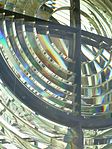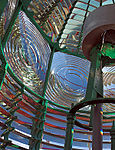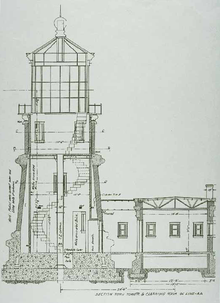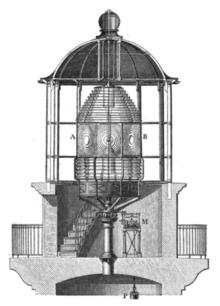- Lighthouse
-
For other uses, see Lighthouse (disambiguation).
 The Roman lighthouse at Dover Castle.
The Roman lighthouse at Dover Castle.
A lighthouse is a tower, building, or other type of structure designed to emit light from a system of lamps and lenses or, in older times, from a fire, and used as an aid to navigation for maritime pilots at sea or on inland waterways.
Lighthouses mark dangerous coastlines, hazardous shoals, reefs, safe entries to harbors, and can also assist in aerial navigation. Once widely used, the number of operational lighthouses has declined due to the expense of maintenance and replacement by modern electronic navigational devices.
Contents
Lighthouse technology
In a lighthouse, the source of light is called the "lamp" (whether electric or fueled by oil) and the concentration of the light is by the "lens" or "optic". Originally lit by open fires and later candles, the Argand hollow wick lamp and parabolic reflector was developed around 1781 in Europe. In the U.S., whale oil was used with solid wicks as the source of light until the Argand parabolic reflector system was introduced around 1810 by Winslow Lewis. Colza oil replaced whale oil in the early 1850s, but U.S. farmers' lack of interest in growing this caused the service to switch to lard oil in the mid 1850s. Kerosene started replacing lard oil in the 1870s and the lighthouse service was finally converted by the late 1880s. Electricity and carbide (acetylene gas) began replacing kerosene around the turn of the 20th century.[1] It was promoted by the Dalén light, which automatically lit the lamp at nightfall and extinguished it at dawn.
Lens technology
Prior to modern strobe lights, lenses were used to concentrate the light from a continuous source. Two tasks were involved:
- vertical light rays of the lamp are redirected into a horizontal plane
- horizontally the light is focused into one or a few directions at a time, with the light beam sweeping around; as a result, in addition to seeing the side of the light beam, the light is directly visible from further away.
Fresnel lens
Main article: Fresnel lensThis concentration of light is accomplished with a rotating lens assembly. In classical period lighthouses, the light source was a kerosene lamp or, earlier, an animal or vegetable oil Argand lamp, and the lenses rotated by a weight driven clockwork assembly wound by lighthouse keepers, sometimes as often as every two hours. The lens assembly sometimes floated in liquid mercury to reduce friction. In more modern lighthouses, electric lights and motor drives were used, generally powered by diesel electric generators. These also supplied electricity for the lighthouse keepers.[1]
Efficiently concentrating the light from a large omnidirectional light source requires a very large diameter lens. This would require a very thick and heavy lens if a conventional lens were used. The invention of the Fresnel lens (pronounced /freɪˈnɛl/) in 1822 by French physicist Augustin-Jean Fresnel revolutionized lighthouses in the 19th century, focusing 85% of a lamp's light versus the 20% focused with the parabolic reflectors of the time. Its design enabled construction of lenses of large size and short focal length without the weight and volume of material in conventional lens designs. Although the Fresnel lens was invented in 1822, it was not used in the U.S. until the 1850s due to the parsimonious administrator of the United States lighthouse establishment, Stephen Pleasonton. With the creation of the United States Lighthouse Board in 1852, all U.S. lighthouses received Fresnel lenses by 1860.[2]
Fresnel lenses are ranked by order, a measure of refracting power, with a first order lens being the largest, most powerful and expensive; and a sixth order lens being the smallest. The order is based on the focal length of the lens. A first order lens has the longest focal length, with the sixth being the shortest. Coastal lighthouses generally use first, second, or third order lenses, while harbor lights and beacons use fourth, fifth, or sixth order lenses.[3]
Some lighthouses, such as those at Cape Race, Newfoundland, and Makapuu Point, Hawaii, used a more powerful hyperradiant Fresnel lens manufactured by the firm of Chance Brothers.
In recent times, many Fresnel lenses have been replaced by rotating aerodrome beacons which require less maintenance. In modern automated lighthouses, this system of rotating lenses is often replaced by a high intensity light that emits brief omnidirectional flashes (concentrating the light in time rather than direction). These lights are similar to obstruction lights used to warn aircraft of tall structures. Recent innovations are "Vega Lights", and initial experiments with Light-emitting diode (LED) panels.[1]
Light characteristics
See also: Light characteristicIn any of these designs an observer, rather than seeing a continuous weak light, sees a brighter light during short time intervals. These instants of bright light are arranged to create a light characteristic or, pattern specific to a lighthouse.[4] For example, the Scheveningen Lighthouse flashes are alternately 2.5 and 7.5 seconds. Some lights have sectors of a particular color (usually formed by colored panes in the lantern) to distinguish safe water areas from dangerous shoals. Modern lighthouses often have unique reflectors or Racon transponders so the radar signature of the light is also unique.
Building
Design
To be effective the lamp must be high enough to be seen before the danger is reached by a mariner. The minimum height is calculated according to trigonometry by taking the square root of the height of the light above the water in feet and multiplying it by 1.17 to yield the distance to the horizon in nautical miles.[5]
Where dangerous shoals are located far off a flat sandy beach, the prototypical tall masonry coastal lighthouse is constructed to assist the navigator making a landfall after an ocean crossing. Often these are cylindrical to reduce the effect of wind on a tall structure, such as Cape May Light. Smaller versions of this design are often used as harbor lights to mark the entrance into a harbor, such as New London Harbor Light.
Where a tall cliff exists, a smaller structure may be placed on top such as at Horton Point Light. Sometimes, such a location can be too high–as along the west coast of the United States. In these cases, lighthouses are placed below clifftop to ensure that they can still be seen at the surface during periods of fog or low clouds, as at Point Reyes Lighthouse. Another victim of fog was former Point Loma Light which was replaced with a lower lighthouse, Point Loma.
As technology advanced, prefabricated skeletal iron or steel structures tended to be used for lighthouses constructed in the 20th century. These often have a narrow cylindrical core surrounded by an open lattice work bracing, such as Finns Point Range Light.
Sometimes a lighthouse needs to be constructed in the water itself. Wave-washed lighthouses are masonry structures constructed to withstand water impact, such as Eddystone Lighthouse in Britain and the St. George Reef Light off California. In shallower bays, Screw-pile lighthouse ironwork structures are screwed into the seabed and a low wooden structure is placed above the open framework, such as Thomas Point Shoal Lighthouse. As screw piles can be disrupted by ice, steel caisson lighthouses such as Orient Point Light are used in cold climates. Orient Long Beach Bar Light (Bug Light) is a blend of a screw pile light that was converted to a caisson light because of the threat of ice damage.[6]
In waters too deep for a conventional structure, a lightship might be used instead of a lighthouse, such as the former lightship Columbia. Most of these have now been replaced by fixed light platforms (such as Ambrose Light) similar to those used for offshore oil exploration.[7]
-
Eddystone Lighthouse, one of the first wave-washed lighthouses
-
Hyperboloid design Adziogol Lighthouse by V.G.Shukhov, Ukraine, 1910
Components
While lighthouse buildings differ depending on the location and purpose, they tend to have common components.
A light station comprises the lighthouse tower and all outbuildings, such as the keeper's living quarters, fuel house, boathouse, and fog-signaling building. The Lighthouse itself consists of a tower structure supporting the lantern room where the light operates.
The lantern room is the glassed-in housing at the top of a lighthouse tower containing the lamp and lens. Its glass storm panes are supported by metal Astragal bars running vertically or diagonally. At the top of the lantern room is a stormproof ventilator designed to remove the smoke of the lamps and the heat that builds in the glass enclosure. A lightning rod and grounding system connected to the metal cupola roof provides a safe conduit for any lightning strikes.
Immediately beneath the lantern room is usually a Watch Room or Service Room where fuel and other supplies were kept and where the keeper prepared the lanterns for the night and often stood watch. The clockworks (for rotating the lenses) were also located there. On a lighthouse tower, an open platform called the gallery is often located outside the watch room (called the Main Gallery) or Lantern Room (Lantern Gallery). This was mainly used for cleaning the outside of the windows of the Lantern Room.[8]
Lighthouses near to each other that are similar in shape are often painted in a unique pattern so they can easily be recognized during daylight, a marking known as a daymark. The black and white barber pole spiral pattern of Cape Hatteras Lighthouse is one example. Race Rocks Light in western Canada is painted in horizontal black and white bands to stand out against the horizon.
Range lights
Main article: Range lights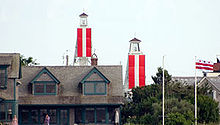 Range Lights in Nantucket, Massachusetts, indicating the observer is left of the desired channel
Range Lights in Nantucket, Massachusetts, indicating the observer is left of the desired channel
Aligning two fixed points on land provides a navigator with a line of position called a range in the U.S. and a transit in Britain. Ranges can be used to precisely align a vessel within a narrow channel such as in a river. With landmarks of a range illuminated with a set of fixed lighthouses, nighttime navigation is possible.
Such paired lighthouses are called range lights in the U.S. and leading lights in the United Kingdom. The closer light is referred to as the beacon or front range; the furthest away is called the rear range. The rear range light is almost always taller than the front.
When the vessel is on the correct course, the two lights line up vertically. But when the observer is out of position, the difference in alignment indicates the proper direction of travel to correct the course.
History
Further information: History of lighthouses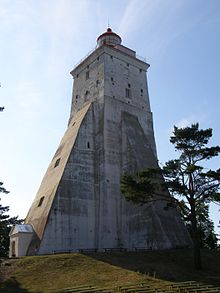 Kõpu Lighthouse in Estonia, the third oldest operating lighthouse in the world.
Kõpu Lighthouse in Estonia, the third oldest operating lighthouse in the world.
Ancient
Perhaps the most famous lighthouse in history is the Lighthouse of Alexandria, built on the island of Pharos in Hellenistic Egypt. The name Pharos is still used as the noun for "lighthouse" in some languages, for example: Albanian, Catalan, and Romanian (far), French (phare), Italian, Galician, and Spanish (faro), Portuguese (farol), Danish, Norwegian, and Swedish (fyr), Bulgarian (фар), and Greek (φάρος). The term pharology (study of lighthouses) also derives from the island's name.[1]
The Lighthouse of Alexandria was built in 280 BC to serve as the port's landmark. With a height variously estimated between 115 and 135 metres (377 and 443 ft) it was among the tallest man made structures on Earth for many centuries, and was identified as one of the Seven Wonders of the World by classical writers. Two lighthouses, each called the Pharos, were built at Dover soon after the Roman conquest of Britain. They were sited on the two heights (Eastern Heights and Western Heights) and modeled on the one built for Caligula's aborted invasion at Boulogne.[1]
Tang Dynasty Chinese writer Jia Dan wrote in his book (written between 785 - 805) that in the sea route forming the opening mouth of the Persian Gulf, the medieval Iranians had erected large minaret towers that served as lighthouses. Confirming the Chinese reports, a century later, Arab writers al-Mas'udi and al-Muqaddasi wrote of the same lighthouses.[1]
In China, the medieval mosque at Canton had a minaret that served as a lighthouse. The later Song Dynasty Chinese pagoda tower built in medieval Hangzhou, known as the Liuhe Pagoda (erected in 1165), also served as a lighthouse for sailors along the Qiantang River.
During the Dark Ages, Roman lighthouses fell into disuse, but some remained functional, such as the Farum Brigantium, now known as the Tower of Hercules, in A Coruña, Spain, and others in the Mediterranean Sea. As navigation improved, lighthouses gradually expanded into Western and Northern Europe.[1] One of the oldest working lighthouses in Europe is Hook Lighthouse located at Hook Head in County Wexford, Ireland. It was built during the medieval period, in a sturdy circular design. A century later, in the Late Middle Ages, a 40-foot (12 m) tower was built by Edward the Black Prince at Cordouan near Gironde, France. One hundred years later, in 1581, Henri III asked architect Louis de Foix to survey it and estimate the cost of repair.[9] The high cost led to de Foix being contracted three years later to build a new one.[10]
Building the lighthouse took twenty-seven years; finally completed in 1611, the tiered Cordouan symbolized French maritime power and prestige. The interior had sumptuous king's apartments, decorated pillars and murals. Its upper level was rebuilt in 1788,[9] and the lighthouse has remained active since. The tower later became the first to use the revolutionary Fresnel lens, in the early 1820s. While visiting at this time, Briton Robert Stevenson was deeply impressed by the work being done with the new light. He sought to expand its use across Scotland as, fueled by the demands of the Age of Sail, lighthouse development began to gain pace.[11]
Classic period
Barnegat Lighthouse, a classic coastal lighthouse built by George Meade on Long Beach Island, New Jersey
Lighthouse development accelerated in the 17th century with Britain's Trinity House constructing its first in 1609, and a national lighthouse services established in Denmark (1650). In the UK, the first Eddystone Lighthouse was lit in 1698, though its third incarnation was the most enduring, designed by John Smeaton and finished in 1759.[12] As Britain became the dominant sea power, lighthouses constructed by the Stevenson family for the Northern Lighthouse Board began to appear in Scotland.[1]
The earliest light in North America was in St. Augustine, Florida, depicted on the map of Boazio, printed in London in 1791. Menendez built the tower after his landing in 1586. Boazio interviewed the Drake's crew upon their return from the sack of St. Augustine.
The next lighthouse in America was Boston Light on Little Brewster Island (1716). The first keeper was George Worthylake who drowned, along with his wife and daughter, when returning to the island in 1718. The original tower was destroyed by the British during the evacuation of Boston in 1775 and eventually reconstructed in 1784. The oldest existing lighthouse in the United States is the Sandy Hook Lighthouse in New Jersey (1764), which is still in operation. By the end of the 19th century, the United States, with its long coastlines had the most lighthouses of any nation.[13]
 A modern automated lighthouse on St. Paul Island
A modern automated lighthouse on St. Paul Island
The US Bureau of Lighthouses was created in 1789 by the 9th Act of the first Congress which placed lighthouses under federal control. Over the years, lighthouses were placed under the direction of U.S. Department of Revenue (disbanded in 1820), U.S. Department of Treasury (until 1903), then the U.S. Department of Commerce. The Lighthouse Board (of the U.S. Lighthouse Establishment) held sway from 1852 to July 1, 1910, when the Lighthouse Service was established. The United States Coast Guard took over on July 7, 1939.[14]
After 1852, the U.S. was divided into lighthouse districts; originally eight, then eventually numbered 19. Each district was run by a naval officer appointed by the Lighthouse Board as the District Inspector. He ran the district in tandem with an Army Corps of Engineers' officer who was in charge of engineering projects. In 1910, civilians started replacing the military officers.[14]
Canada's first lighthouse was the Louisbourg Light built by the French in Nova Scotia in 1734. It was destroyed during the Siege of Louisbourg in 1758. The British built the Sambro Island Light at Halifax, Nova Scotia in the same year which has survived to the present day, making it the oldest surviving lighthouse in North America. The network of lighthouses built by the colonies of British North America were united in 1867 by the Canadian government which greatly expanded the Canadian lighthouse system through the Canadian Department of Marine, largely through economical wooden lighthouses staffed by families.[15]
Lighthouses were extremely labour intensive in the classic era of lighthouse operation. Lighthouse keepers were needed to trim the wicks, replenish fuel, wind clockworks, and perform maintenance tasks such as cleaning lenses and windows. In 1907, Nils Gustaf Dalén produced the sun valve which turned the beacon on and off using daylight. The first one was erected on Furuholmen Lighthouse lighthouse between Stockholm and Vaxholm.[16] In 1912 Dalén was awarded the Nobel Prize in Physics for his invention of 'automatic valves designed to be used in combination with gas accumulators in lighthouses'.[17]
Dalén's inventions, electrification, and automatic lamp changers began to make lighthouse keepers obsolete. For many years, lighthouses still had keepers, partly because lighthouse keepers could serve as a rescue service if necessary. Improvements in maritime navigation and safety such as the Global Positioning System (GPS) have led to the phasing out of non-automated lighthouses in the United States, with the last keepers removed in the 1990s.[18] In Canada, this trend has been stopped and there are still 50 staffed light stations, with 27 on the west coast alone.[19]
Modern
Often in inaccessible locations, modern lighthouses are more functional and less picturesque; usually they use solar-charged batteries and have a single stationary flashing light sitting on a steel skeleton tower. The last manned lighthouse built in the U.S. was the Charleston Light constructed in 1962. Resembling an air traffic control tower, it features a modern triangular shape, aluminum alloy skin, air conditioning, and an elevator.[1]
Famous lighthouse builders
 Point Reyes Lighthouse, showing the lighthouse and buildings comprising the light station
Point Reyes Lighthouse, showing the lighthouse and buildings comprising the light station
John Smeaton is noteworthy for having designed the third and most famous Eddystone Lighthouse but some builders are well known for their work in building multiple lighthouses. The Stevenson family (Robert, Alan, David, Thomas, David Alan, and Charles) made lighthouse building a three generation profession in Scotland. Irishman Alexander Mitchell invented and built a number of screwpile lighthouses despite his blindness.
United States Army Corps of Engineers Lieutenant George Meade built numerous lighthouses along the Atlantic and Gulf coasts before gaining wider fame as the winning general at the Battle of Gettysburg. Colonel Orlando M. Poe, engineer to General William Tecumseh Sherman in the Siege of Atlanta, designed and built some of the most exotic lighthouses in the most difficult locations on the U.S. Great Lakes. Alexander Ballantyne built two of the most challenging wave-washed lighthouses on barren rock in the Pacific, Tillamook Rock Light and St. George Reef Light.[20] Englishman James Douglass was knighted for his work on lighthouses.
French merchant navy officer Marius Michel Pasha built almost a hundred lighthouses along the coasts of the Ottoman Empire in a period of twenty years after the Crimean War (1853–1856).[21]
Maintenance
In the United States, lighthouses are maintained by the United States Coast Guard (USCG).[14] Those in England and Wales are looked after by Trinity House; in Scotland, by the Northern Lighthouse Board; and in Ireland by the Commissioners of Irish Lights. In Canada, they are managed by the Canadian Coast Guard. In Australia, lighthouses are conducted by the Australian Maritime Safety Authority.
The Soviet Union built a number of automated lighthouses powered by radioisotope thermoelectric generators in remote locations. They operated for long periods without external support with great reliability.[22] However numerous installations deteriorated, were stolen, or vandalized. Some cannot be found due to poor record keeping.[23]
Preservation
As lighthouses became less essential to navigation, many of their historic structures faced demolition or neglect. In the United States, the National Historic Lighthouse Preservation Act of 2000 provides for the transfer of lighthouse structures to local governments and private non-profit groups, while the USCG continues to maintain the lamps and lenses. In Canada, the Nova Scotia Lighthouse Preservation Society won heritage status for Sambro Island Lighthouse, and sponsored the Heritage Lighthouse Protection Act to change Canadian federal laws to protect lighthouses.[24]
Many groups formed to restore and save lighthouses around the world. They include the World Lighthouse Society and the United States Lighthouse Society.[25] A further international group is the Amateur Radio Lighthouse Society, which sends amateur radio operators to publicize the preservation of remote lighthouses throughout the world.[26]
Popular culture and symbolism
 Split Point Lighthouse, used in the popular Australian TV series Round the Twist
Split Point Lighthouse, used in the popular Australian TV series Round the Twist
 Cabo Branco Lighthouse in João Pessoa, Brazil is a major attraction at the easternmost inland point of the Americas
Cabo Branco Lighthouse in João Pessoa, Brazil is a major attraction at the easternmost inland point of the Americas
Visiting and photographing lighthouses are popular hobbies as is collecting ceramic replicas. Some lighthouses are popular travel destinations in their own right, and the buildings maintained as tourist attractions. In the U.S., National Lighthouse and Lightship Weekend is celebrated on the first weekend of August, and International Lighthouse and Lightship Weekend on the third weekend. Many lighthouses are open to the public and amateur radio operators communicate between them on these days.
Lighthouses are popular icons on vehicle license plates. Barnegat Lighthouse, Tuckerton Island Lighthouse, Thomas Point Shoal Light, Saybrook Breakwater Light, White Shoal Light, and Biloxi Light are so depicted.[27]
The Disney film Pete's Dragon featured a lighthouse and the resulting Helen Reddy song Candle on the Water alludes to it. The Australian television series Round the Twist also involved a family living at Split Point Lighthouse. The long-running American soap opera Guiding Light has featured a lighthouse in many of its opening title segments, and the fictional Springfield, Illinois has a lighthouse situated near the town.[28]
To recognize the role of lighthouse keepers in maritime safety, the U.S. Coast Guard named a class of 175-foot (53 m) coastal buoy tenders after famous U.S. lighthouse keepers. Fourteen ships in the class were built between 1996 and 2000.[29]
Due to their function as beacons of safety, organizations choose lighthouses as a symbol. The lighthouse is the symbol of Lighthouse International, a U.S. organization for the blind.[30] Lighthouses are often interpreted in dreams as beacons of truth or as male fertility and influence.
Lighthouses were once regarded as an archetypal public good, because ships could benefit from the light without being forced to pay. One reason the Confederacy broke off from the United States was the former's opposition to most taxpayer-funded internal improvements; yet even the Confederate States Constitution explicitly allowed public funds to be spent on lighthouses.[31]
A widely-disseminated urban legend tells of a radio conversation between a U.S. or British naval vessel and what is believed to be another ship on a collision course. The naval vessel insists the other ship change course, but the other ship continues to insist the naval vessel do so. After the captain of the naval vessel identifies himself and demands a course change, the other party responds with, "I'm a lighthouse. It's your call".
Their isolated and mysterious nature makes lighthouses a frequent setting of horror and suspense films, as well as adventure video games. Recently, a lighthouse played a pivotal role in Martin Scorsese's Shutter Island, and was featured in the final shot of the film.
St. Anthony's Lighthouse at St. Anthony's Head near Falmouth, Cornwall was featured in the title sequence of the children's live action puppet television program series Fraggle Rock created by Jim Henson.
-
A rarer type of lighthouse on stilts in the Hauraki Gulf of New Zealand. Mostly protected by nearby islands, Bean Rock lighthouse lights the way into the Waitemata Harbour.
-
Lighthouse "El Faro", Maspalomas, Gran Canaria.
See also
References
- Notes
- ^ a b c d e f g h i Crompton & Rhein (2002)
- ^ "Lighthouses: An Administrative History". Maritime Heritage Program – Lighthouse Heritage. U.S. National Park Service. http://www.nps.gov/history/maritime/light/admin.htm. Retrieved 2008-06-10.
- ^ Lighthouse Lenses and Illuminants
- ^ Aids To Navigation Abbreviations
- ^ How far is the horizon? - BoatSafe Kids!
- ^ Lighthouse Construction Types
- ^ Lightships of the U.S.
- ^ "Light Station Components". nps.gov. http://www.nps.gov/history/maritime/ltcomp.htm.
- ^ a b (Beaver 17)
- ^ (Stevenson 32–33)
- ^ (Bathurst 135)
- ^ Palmer, Mike (2005). Eddystone: the Finger of Light (2nd ed.). Woodbridge, Suffolk: Seafarer Books. ISBN 0-9547062-0-X.
- ^ Jones & Robert (1998)
- ^ a b c Lighthouses: An Administrative History
- ^ Thurston, Harry, Against Darkness and Storm: Lighthouses of the Northeast Halifax: Nimbus, 1993, p. 4-5
- ^ History - The Sun Valve
- ^ Gustaf Dalén - Biography
- ^ Lighthouse Keepers in the Nineteenth Century
- ^ [1]
- ^ Architects, Engineers and Contractors
- ^ Guigueno, Vincent. "Review of Thobie, Jacques, L'administration generale des phares de l'Empire ottoman et la societe Collas et Michel, 1860-1960. H-Mediterranean, H-Net Reviews. January, 2006". Humanities and Social Sciences Net Online. http://www.h-net.org/reviews/showrev.php?id=11049. Retrieved 2010-09-20.
- ^ AEI: September 1996, RTG Materials
- ^ Radioisotope Thermoelectric Generators - Bellona
- ^ Douglas Franklin. "Lighthouse Bill Protecting Our Lighthouses – The Icons of Canada's Maritime Heritage". Featured Heritage Buildings. Canadian Heritage Foundation. http://www.heritagecanada.org/eng/featured/current.html. Retrieved 2008-06-10.
- ^ Welcome to The United States Lighthouse Society
- ^ Amateur Radio Lighthouse Society
- ^ http://www.sunherald.com/306/story/114405.html
- ^ The Guiding Light Retrieved 16 July 2009.
- ^ USCG: About Us - Aircraft & Cutters
- ^ Lighthouse International
- ^ The Avalon Project : Constitution of the Confederate States; March 11, 1861
- Bibliography
- Bathurst, Bella. The lighthouse Stevensons. New York: Perennial, 2000. ISBN 0-06-093226-0
- Beaver, Patrick. A History of Lighthouses. London: Peter Davies Ltd, 1971. ISBN 0-432-01290-7.
- Crompton, Samuel, W; Rhein, Michael, J. The Ultimate Book of Lighthouses. San Diego, CA: Thunder Bay Press, 2002. ISBN 1-59223-102-0.
- Jones, Ray; Roberts, Bruce. American Lighthouses. Globe Pequot, 1998. 1st ed. ISBN 0-7627-0324-5.
- Stevenson, D. Alan. The world's lighthouses before 1820. London: Oxford University Press, 1959.
- Further reading
- Noble, Dennis. Lighthouses & Keepers: U. S. Lighthouse Service and Its Legacy. Annapolis: U.S. Naval Institute Press, 1997. ISBN 1-55750-638-8.
- Putnam, George R. Lighthouses and Lightships of the United States. Boston: Houghton Mifflin Co., 1933.
- Weiss, George. The Lighthouse Service, Its History, Activities and Organization. Baltimore: Johns Hopkins Press, 1926.
External links
- "Lighthouses Of Strange Designs, December 1930, Popular Science
- Photograph of Makapuu Point hyperradiant lens, U.S.C.G. at lighthouse friends.
- Rowlett, Russ. "The Lighthouse Directory". University of North Carolina at Chapel Hill. http://www.unc.edu/~rowlett/lighthouse/index.htm. Research tool with details of over 13,000 lighthouses and navigation lights around the world with photos and links.
- U.S. lighthouses website with over 4400 images and information on all relevant U.S. lighthouses
- Lighthouse Explorer website The Lighthouse Explorer Database, with over 7500 lighthouses listed in searchable format, with photos, directions, historical information, and other details
Categories:- Lighthouses
- Navigation
Wikimedia Foundation. 2010.






